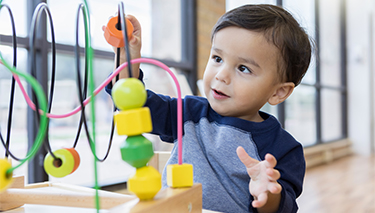Seeing is learning
Vision 2020 Australia estimates that about 80% of what is learned is achieved through vision. For a young child who is constantly learning about the world at such a fast rate, it is crucial that good eye health is maintained. With experts from the Australian Research Centre of Excellence in Vision Science claiming that vision gradually declines after the age of 15, it is even more important that any eye problems are diagnosed and treated as early as possible.
What are the most common problems in young children?
- Myopia or short-sightedness is a condition where objects at short distances can be seen clearly but distant objects appear blurred. It was a long held belief among optometrists and researchers that genetics, improper reading habits and working in poor lighting conditions causes Myopia. However, Kathryn Rose, an international researcher of visual disorders from the University of Sydney confirms that recent studies conducted reveal that a lack of sunlight may actually be true culprit of this condition. So get the kids out into the backyard for a play and a bit of sunlight. Not only will it help their overall health but it will be doing their eyesight a whole lot of good too.
- Hyperopia or long-sightedness is a condition where objects at a distance can be seen clearly but those closer to the eye can look blurred or cause eyestrain. Most newborns have this condition and as they grow, it begins to decrease in severity. It is believed that the condition is largely hereditary.
- Astigmatism is a condition where objects appear blurred at all distances. This occurs as the cornea in the eye is not curved evenly in all directions causing it to bend light at different amounts.
- Strabismus or turned eye is a condition where one or both eyes can be turned inward, outward, up or down. It usually occurs because of the failure of the eye muscles to work together.
- Amblyopia or lazy eye is a serious condition which can result from an untreated turned eye, blockage due to cataract, trauma or lid droop. The brain suppresses images seen by the amblyopic eye to such an extent that a permanent decrease in vision can occur in this eye. While an obvious squint can easily be spotted, Amblyopia without any eye deviation may not be that easy to notice.
Why is it important to get an early diagnosis?
- Without an ability to see the blackboard clearly at school, children can find it difficult to keep up at school. In fact, according to Sight Matters, approximately one in ten pre-schoolers have a “clinically significant visual problem”. Without appropriate treatment, this visual problem may become a contributing factor in having vision-related learning difficulties later in school.
- Children often are not aware that they have a problem with their vision as they think everyone else sees the world the same way they do.
- According to the Royal Australian and New Zealand College of Ophthalmologists, untreated Amblyopia may become a cause of unemployment in young adults as their vision is considered inadequate for some occupations. When this condition is caused by a squint, it becomes a bit of a disfigurement that can be the cause of school-yard bullying and ridicule.
- Eye problems may actually be an indicator that the child has diabetes. In fact, Diabetes Australia warns that if a child suddenly develops blurred vision, it may be a symptom of type 1 diabetes.
Prevention
- Encourage children to spend more time outdoors rather than being cooped up indoors playing computer and/or video games. There are lots of benefits to outdoor play and heaps of different activities you can try. Rose’s study found that an exposure of between 10-14 hours of sunlight per week appears to have a preventative effect for developing Myopia. However, it is also important to minimise UV damage, so the usual sun protection should be used.
- Encourage your child to maintain a proper posture while reading and working/playing on the computer.
- Recent research conducted suggests that the nutrient DHA plays an important role in eye development of young children. Breast milk is naturally rich in DHA and now even some infant formulas and toddler milk drinks contain this important ingredient.
- Foods such as dark green vegetables and eggs should be consumed. These are rich in Lutein – an anti-oxidant and nutrient essential for good vision. There are lots of recipes for children of all ages in our Huggies recipe finder.
- A diet rich in Vitamin A should be adapted as it is important for maintaining good eye health.
- The Optometrists Association of Australia suggests that children should have an eye test just before starting school and regularly through primary and secondary school. They also suggest that if the child displays any of the following symptoms, they should be booked in for an eye examination:
- Squinting
- Bringing books and objects close to the eyes
- Complaining of headaches often
- Blinking frequently and presenting with red or sore eyes
Treatment and management options
Treatment will of course be decided individually for each child in consultation with your optometrist and local doctor. As a general guide though:
Glasses and Contact lenses
Glasses and contact lenses remain the most commonly prescribed treatment for conditions like Myopia, Hyperopia and Astigmatism. For Amblyopia, Occlusion or Patching – which involves patching the “good” eye to give the amblyopic eye a chance to develop better vision, may be recommended. The age of the child does play an important role in determining the right option though, for example contact lenses are usually not recommended for very young children.
Vision therapy treatment
Vision therapy programs that involve eye exercise and application of light to bring about changes to visual function and health can be used on children of all ages. The technologies behind these eye condition management options are part of new developments in the field of eye care called Behavioural Optometry. Chih-Chi Lee, a behavioural optometrist from Thompson, Larter, Lee & Associates in Sydney explains that Behavioural Optometry “looks into your visual function, eye teaming, eye tracking, eye focusing and visual thinking.” This field of optometry is especially useful for children as it is an alternative and non-invasive treatment option for many common eye conditions.
Orthokeratology
Other exciting technologies like Orthokeratology may also be recommended by a behavioural optometrist as alternatives or in addition to mainstream treatment options. Chih-Chi Lee describes Orthokeratology as a technique where “you wear hard contact lenses at night time and it works by altering the shape of the cornea temporarily to weaken short-sightedness during waking hours.” However, this technique is usually only prescribed for children over the age of 11 due to the fact that it involves contact lens wear which requires a certain amount of responsibility.
Eyelights
Eyelights are new products developed by an American chiropractor and it is mainly used in the treatment of Amblyopia (lazy eye) and Strabismus (turned eye). Eyelights look just like glasses and they work by intermittently flashing LEDs before the lazy eye to stimulate the part of the brain that deals with processing images from that eye. Repeated use over a period of weeks may result in achieving improved awareness of images from both eyes, therefore resulting in better “binocular” vision. These glasses can only be worn by children over five as their head needs to be a certain size to achieve a good fit.
Surgery
While the effects of techniques like Orthokeratology are temporary, a more permanent, long-term management option is surgery. Surgery is usually not recommended for young children with conditions such as short-sightedness as the eyes are still developing and the cornea continues to change its shape. However, for conditions like Strabismus, surgery may be performed on young children. Even if surgery is recommended, only a cosmetic change will be observed where the affected eye is corrected so it does not look turned. Vision therapy will still be recommended before and after surgery to improve efficiency of the binocular vision system.
Sources include:
Vision2020 Australia, ARC Centre of Excellence in Vision Science, EyeCollege.com,
CNN.com, LazyEye.org, Sight Matters, Royal Australian and New Zealand College of Ophthalmologists, Optometrists Association of Australia and Thompson, Larter, Lee & Associates.
This article was provided by Lakshmi Singh, a freelance writer and a mother of two.
Last Published* October, 2024
*Please note that the published date may not be the same as the date that the content was created and that information above may have changed since.




















